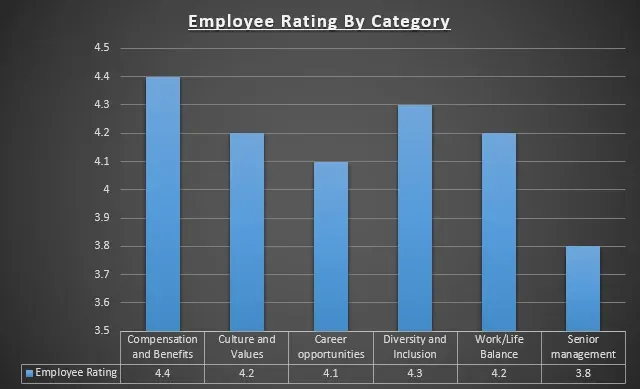Membuka Faedah & Faedah: Ketahui Ganjaran Anda Hari Ini

Pendekatan Trailblazing Google untuk Pampasan dan Faedah
Dalam landskap pemerolehan dan pengekalan bakat yang sangat kompetitif, Google telah muncul sebagai suar inovasi, menetapkan piawaian baharu dengan pendekatan pecah tanahnya terhadap pampasan dan faedah. Komitmen Google terhadap ekuiti, ketelusan dan kesejahteraan pekerja yang holistik telah mengubah budaya korporatnya dan meningkatkannya sebagai model untuk organisasi di seluruh dunia.
- Ketelusan: Ketelusan Google tentang maklumat kewangan dengan pekerja meningkatkan motivasi dan produktiviti.
- Kesejahteraan holistik: Google mengutamakan kesejahteraan pekerja dengan perkhidmatan penjagaan kesihatan di lokasi, pilihan tempat makan gourmet dan inisiatif kesejahteraan, yang membawa kepada tenaga kerja yang lebih terlibat.
- Inovasi dan Keterangkuman: Pampasan dan faedah Google mengutamakan kreativiti dan program kesejahteraan yang komprehensif, memupuk budaya inovasi dan keterangkuman untuk menarik bakat terbaik dan sejajar dengan misi mereka.
Tumpuan strategik terhadap pampasan dan faedah telah menghasilkan hasil yang ketara. Syarikat itu secara konsisten menarik dan mengekalkan bakat terbaik, memacu inovasi dan memacu pertumbuhan. Tahap kepuasan dan penglibatan pekerja adalah tinggi, yang membawa kepada peningkatan produktiviti dan prestasi. Kejayaan Google menjadi bukti kepada kuasa transformatif inisiatif strategik berfokuskan pekerja.

Meningkatkan kebahagiaan di tempat kerja: kuasa faedah dan faedah pekerja
Dalam pasaran kerja yang kompetitif hari ini, menarik dan mengekalkan bakat terbaik melangkaui menawarkan gaji yang kompetitif. Syarikat-syarikat semakin menyedari pentingnya menyediakan faedah dan faedah yang menarik untuk memastikan pekerja mereka terlibat, bermotivasi, dan berpuas hati. Daripada rancangan penjagaan kesihatan tradisional kepada faedah yang lebih tidak konvensional seperti pejabat mesra haiwan peliharaan dan wang saku kesihatan, landskap faedah pekerja berkembang untuk memenuhi pelbagai keperluan dan keutamaan pekerja moden.
Memahami kepentingan faedah dan faedah pekerja
Faedah dan faedah pekerja memainkan peranan penting dalam membentuk pengalaman pekerja secara keseluruhan. Di luar pampasan kewangan, mereka menunjukkan komitmen syarikat terhadap kesejahteraan dan kebahagiaan pekerjanya. Dengan menawarkan pakej faedah yang komprehensif, organisasi dapat meningkatkan kepuasan pekerja, mengurangkan kadar perolehan, dan akhirnya meningkatkan produktiviti dan prestasi.
Komponen utama faedah dan faedah pekerja
- Liputan penjagaan kesihatan: Perlindungan penjagaan kesihatan yang komprehensif, termasuk pelan perubatan, pergigian, dan penglihatan, sering menjadi keutamaan bagi pekerja. Menyediakan akses kepada penjagaan kesihatan yang berkualiti bukan sahaja menggalakkan kesejahteraan fizikal tetapi juga menawarkan ketenangan fikiran kepada pekerja dan keluarga mereka.
- Pelan Persaraan: Faedah persaraan seperti pelan 401 (k) dengan caruman padanan majikan memberi kuasa kepada pekerja untuk merancang masa depan kewangan mereka. Pelan ini bukan sahaja berfungsi sebagai alat simpanan yang berharga tetapi juga menunjukkan pelaburan jangka panjang organisasi dalam kejayaan dan kestabilan pekerjanya.
- Pengaturan Kerja Fleksibel: Menawarkan pengaturan kerja yang fleksibel, termasuk pilihan kerja jarak jauh dan penjadualan yang fleksibel, membolehkan pekerja mencapai keseimbangan kerja-kehidupan yang lebih baik. Fleksibiliti ini amat dihargai oleh ibu bapa, penjaga, dan individu yang bekerja dengan keperluan gaya hidup yang pelbagai.
- Peluang Pembangunan Profesional: Melabur dalam pertumbuhan dan pembangunan pekerja melalui program latihan, pembayaran balik tuisyen, dan inisiatif bimbingan memupuk budaya pembelajaran berterusan dan kemajuan kerjaya. Memberi peluang untuk peningkatan kemahiran dan kemajuan kerjaya meningkatkan penglibatan dan kesetiaan pekerja.
- Program Kesejahteraan: Menggalakkan kesejahteraan pekerja melalui inisiatif seperti keahlian gim, sumber kesihatan mental, dan stipends kesihatan menggalakkan gaya hidup yang lebih sihat dan mengurangkan tahap tekanan. Dengan mengutamakan kesejahteraan pekerja, organisasi dapat meningkatkan semangat dan produktiviti sambil mengurangkan ketidakhadiran dan kos penjagaan kesihatan.
- Inisiatif Keseimbangan Kerja-Kehidupan: Melaksanakan dasar yang menggalakkan keseimbangan kerja-kehidupan, seperti cuti berbayar yang murah hati, cuti ibu bapa, dan jadual cuti yang fleksibel, menunjukkan rasa hormat terhadap masa peribadi pekerja dan memupuk budaya kerja positif yang dibina atas kepercayaan dan saling menghormati.
- Faedah dan Insentif: Faedah dan insentif tambahan, seperti diskaun pekerja, faedah komuter, kemudahan di lokasi (contohnya, kafeteria, kemudahan rekreasi), dan acara yang ditaja oleh syarikat, meningkatkan pengalaman pekerja keseluruhan dan menyumbang kepada rasa kekitaan dan keakraban dalam organisasi.
Di mana Nombor Bercakap Jumlah!
Terokai dunia di mana data menceritakan kisah menarik! Selami 'Di mana Nombor Bercakap Jilid,' di mana setiap angka membuka cerapan, mendedahkan naratif yang tidak diberitahu yang tersembunyi dalam statistik.
Dalam pasaran pengambilan pekerja yang kompetitif hari ini, menawarkan pakej faedah yang mantap adalah penting untuk menarik dan mengekalkan bakat terbaik. Laporan ini mengkaji kepentingan manfaat pekerja dalam keputusan pemilihan pekerjaan, menonjolkan penemuan utama dari tinjauan dan kajian yang dijalankan di lapangan.
Kepentingan Faedah dalam Pemilihan Pekerjaan: Menurut Kajian Keyakinan Pekerjaan 2015 Glassdoor, kira-kira 60% individu mempertimbangkan faedah dan faedah faktor utama apabila menilai tawaran pekerjaan. Selain itu, 80% pekerja mengutamakan faedah tambahan berbanding kenaikan gaji, menekankan kepentingan pakej faedah komprehensif.
Nilai Faedah Keseimbangan Fleksibel dan Kerja-Kehidupan: Satu tinjauan oleh Fractl mendedahkan bahawa, selepas insurans kesihatan, pekerja meletakkan nilai tertinggi pada faedah yang meningkatkan fleksibiliti dan keseimbangan kerja-kehidupan. Waktu yang fleksibel, lebih banyak masa percutian, pilihan kerja dari rumah, dan masa percutian tanpa had dikenal pasti sebagai faktor utama dalam keputusan pemilihan pekerjaan.
Faedah Mampu Milik dengan Impak Tinggi: Waktu fleksibel dan pengaturan kerja dari rumah sangat dihargai oleh responden dan merupakan faedah kos efektif untuk majikan. Masa percutian tanpa had menarik bagi 80% responden dan boleh menjadi penyelesaian menang-menang untuk majikan dan pekerja, yang berpotensi mengurangkan kos liabiliti.
Bantuan Pendidikan dan Faedah Pinjaman Pelajar: Pinjaman pelajar dan bantuan tuisyen menduduki tempat yang sangat tinggi di antara faedah yang didambakan, dengan hampir separuh daripada responden mempertimbangkannya ketika menilai tawaran pekerjaan. Walaupun terdapat kos yang dirasakan, syarikat boleh memanfaatkan pengecualian cukai untuk memberikan bantuan pendidikan, meningkatkan daya tarikan mereka kepada pekerja yang berpotensi.
Perbezaan Jantina dalam Keutamaan Faedah: Wanita lebih cenderung mengutamakan faedah keluarga seperti cuti ibu bapa berbayar dan perkhidmatan penjagaan harian percuma. Lelaki, sebaliknya, menunjukkan keutamaan untuk acara ikatan pasukan, berundur, dan makanan percuma.
Kesimpulannya, penemuan ini menekankan kepentingan menawarkan pelbagai faedah untuk memenuhi keperluan dan keutamaan pekerja yang berbeza-beza. Walaupun faedah tradisional seperti insurans kesihatan kekal kritikal, pengaturan fleksibel, bantuan pendidikan, dan faedah keluarga semakin dihargai oleh tenaga kerja hari ini. Dengan menyelaraskan faedah dengan keutamaan dan keutamaan pekerja, organisasi dapat meningkatkan daya saing mereka dalam pasaran bakat dan memupuk budaya tempat kerja yang positif.
Meningkatkan kesejahteraan dan penglibatan pekerja di salesforce Inc.
Latar belakang
Salesforce Inc. adalah pembekal terkemuka perisian pengurusan perhubungan pelanggan (CRM) berasaskan awan, memenuhi pelbagai industri termasuk automotif, runcit, perkhidmatan kewangan, pendidikan, dan penjagaan kesihatan. Beribu pejabat di San Francisco, Salesforce mempunyai kehadiran global dengan pejabat di seluruh Amerika Syarikat, Eropah, Timur Tengah, Asia, dan Amerika Selatan. Selain itu, Salesforce memiliki Tableau, alat analisis data dan visualisasi, dan Slack, aplikasi pemesejan yang popular.
Cabaran
Dengan tenaga kerja yang pelbagai tersebar di pelbagai lokasi di seluruh dunia, Salesforce menghadapi cabaran untuk memupuk kesejahteraan dan penglibatan pekerja sambil memastikan produktiviti dan kepuasan.
Penyelesaian
Salesforce melaksanakan pendekatan komprehensif untuk kesejahteraan dan penglibatan pekerja, mengintegrasikan pelbagai inisiatif dan faedah ke dalam budaya korporatnya:
1. Polisi Cuti Berbayar (PTO):
- Pekerja setiap jam di A.S. mula mengumpul PTO dari hari pertama, memupuk budaya keseimbangan kerja-kehidupan dan mengiktiraf kepentingan kelonggaran.
- Pekerja bergaji mendapat manfaat daripada dasar cuti yang fleksibel, membolehkan mereka menguruskan masa mereka dengan berkesan dan berehat apabila diperlukan.
2. Program Cuti Sukarela (VTO):
- Salesforce menggalakkan pekerja untuk berbakti kepada komuniti mereka dengan menawarkan sehingga tujuh hari cuti sukarelawan berbayar setiap tahun.
- Program ini bukan sahaja menyokong pekerja dalam menyumbang kepada sebab-sebab yang mereka minati tetapi juga menguatkan rasa tujuan dan hubungan mereka dengan nilai-nilai syarikat.
3. Sumber Kesejahteraan:
- Salesforce menyediakan sumber untuk kesejahteraan pekerja dan pengurusan tekanan, mengiktiraf kepentingan kesihatan mental.
- Banyak pejabat mempunyai "zon kesedaran" khusus untuk meditasi, mempromosikan kelonggaran dan kesedaran di tengah-tengah hari kerja yang sibuk.
- Melalui perkongsian dengan BetterUp, pekerja mempunyai akses kepada jurulatih kesejahteraan yang berdedikasi untuk menyokong mereka dalam mencapai matlamat peribadi dan profesional mereka, meningkatkan lagi kesejahteraan keseluruhan mereka.
Hasil:
Pendekatan holistik Salesforce terhadap kesejahteraan dan penglibatan pekerja telah menghasilkan beberapa hasil positif:
- Pekerja berasa dihargai dan disokong, yang membawa kepada tahap kepuasan kerja dan kesetiaan yang lebih tinggi kepada syarikat.
- Dengan mengutamakan kesejahteraan pekerja, Salesforce telah mewujudkan persekitaran kerja yang positif yang kondusif untuk produktiviti dan inovasi.
- Program VTO memberi kuasa kepada pekerja untuk membuat perbezaan dalam komuniti mereka, mengukuhkan komitmen Salesforce terhadap tanggungjawab sosial korporat.
- Tumpuan Salesforce terhadap kesejahteraan dan penglibatan pekerja meningkatkan reputasinya sebagai majikan pilihan, menarik bakat terbaik dalam pasaran yang kompetitif.
Dengan mengutamakan kesejahteraan dan penglibatan pekerja melalui inisiatif seperti dasar cuti masa fleksibel, program sukarelawan, dan sumber kesejahteraan, Salesforce telah mewujudkan budaya kerja yang menyokong dan inklusif. Ini bukan sahaja memberi manfaat kepada pekerja secara peribadi dan profesional tetapi juga menyumbang kepada kejayaan keseluruhan syarikat dan kesan positif kepada masyarakat.
Pendekatan Salesforce berfungsi sebagai model bagi organisasi yang ingin memupuk tempat kerja yang berkembang maju di mana pekerja merasa dihargai, diberi kuasa, dan bermotivasi untuk mencapai potensi penuh mereka.
Microsoft's strategic approach to compensation and benefits
Microsoft adalah gergasi teknologi global yang telah mengukuhkan dirinya sebagai peneraju dalam pampasan dan faedah dengan mengutamakan ekuiti dan ganjaran jangka panjang dalam strateginya. Komitmen syarikat untuk menyelaraskan insentif pekerja dengan kejayaan organisasi telah menjadi ciri menentukan falsafah pampasannya.
Cabaran
Microsoft menghadapi cabaran untuk menarik dan mengekalkan bakat terbaik dalam industri yang kompetitif sambil memupuk budaya pemilikan dan komitmen di kalangan tenaga kerjanya.
Penyelesaian
Microsoft melaksanakan pendekatan inovatif terhadap pampasan dan faedah yang berpusat di sekitar prinsip pemilikan ekuiti dan ganjaran jangka panjang:
1. Pemilikan Ekuiti:
- Microsoft percaya bahawa apabila pekerja mempunyai kepentingan dalam prestasi syarikat, mereka lebih terlibat dan bermotivasi untuk menyumbang kepada kejayaannya.
- Syarikat itu menawarkan pampasan berasaskan saham kepada sebahagian besar tenaga kerjanya, menyediakan pekerja dengan kepentingan langsung dalam pertumbuhan dan prestasi kewangan Microsoft.
2. Faedah Jangka Panjang:
- Menyedari kepentingan ganjaran mampan, Microsoft menyediakan faedah yang terakru dari semasa ke semasa, seperti opsyen saham dan pelan persaraan.
- Dengan menawarkan faedah yang sejajar dengan matlamat jangka panjang pekerja, Microsoft memupuk kesetiaan dan komitmen, memupuk rasa perkongsian antara syarikat dan pekerjanya.
Hasil: Pendekatan inovatif Microsoft terhadap pampasan dan faedah telah menghasilkan beberapa hasil positif:
1. Penglibatan pekerja yang dipertingkatkan: Pekerja merasakan rasa pemilikan dan akauntabiliti untuk kejayaan syarikat, yang membawa kepada tahap penglibatan dan produktiviti yang lebih tinggi.
2. Pengekalan yang dipertingkatkan: Dengan menawarkan ganjaran dan faedah jangka panjang, Microsoft menarik dan mengekalkan bakat terbaik, mengurangkan perolehan dan memastikan kesinambungan dalam tenaga kerjanya.
3. Penjajaran kepentingan: Tumpuan Microsoft terhadap pemilikan ekuiti menjajarkan kepentingan pekerja dengan organisasi, memupuk budaya kerjasama dan matlamat bersama.
4. Promosi inovasi: Apabila pekerja mempunyai kepentingan langsung dalam pertumbuhan syarikat, mereka bermotivasi untuk memacu inovasi dan kecemerlangan, menyumbang kepada kejayaan berterusan Microsoft dalam industri teknologi.
Penekanan Microsoft terhadap ekuiti dan faedah jangka panjang menunjukkan kuasa menyelaraskan pampasan dengan matlamat bersama. Dengan mengutamakan pemilikan dan ganjaran mampan, Microsoft bukan sahaja memupuk kesetiaan dan komitmen di kalangan pekerjanya tetapi juga mewujudkan tenaga kerja yang berdedikasi untuk membina masa depan yang makmur untuk diri mereka sendiri dan syarikat.
Ini adalah bukti keberkesanan strategi pampasan berpandangan ke hadapan yang mengutamakan kedua-dua ganjaran segera dan berkekalan, menawarkan pandangan berharga bagi organisasi yang ingin menarik, mengekalkan, dan memotivasi bakat dalam landskap kompetitif hari ini.
Empuls daripada Plum ialah platform penglibatan pekerja semua-dalam-satu yang direka untuk meningkatkan budaya dan ketersambungan tempat kerja. Dengan ciri yang terdiri daripada tinjauan dan pengiktirafan kepada ganjaran dan alat komunikasi dalaman, Empuls memperkasakan pemimpin HR untuk memupuk budaya penghargaan dan penglibatan dalam organisasi mereka. Dipercayai oleh lebih 1000 pelanggan dan 500,000 pekerja, Empuls menawarkan antara muka mesra pengguna dan penyepaduan yang lancar dengan aplikasi kerja sedia ada, menjadikannya penyelesaian komprehensif untuk penglibatan pekerja holistik.
Membungkus
"Menarik, mengekalkan, dan melibatkan bakat terbaik dengan faedah dan faedah syarikat yang komprehensif! Ketahui mengapa menawarkan insurans kesihatan, rancangan persaraan, pengaturan kerja yang fleksibel, dan program kesejahteraan adalah penting untuk memupuk persekitaran kerja yang positif dan memacu kejayaan jangka panjang. Utamakan kesejahteraan pekerja untuk memupuk tenaga kerja yang lebih bahagia, bermotivasi dan produktif."